This story published
01/21/97
ODE
TO JOY AND FREEDOM
The
Fall of the Berlin Wall
by
Ursula
Grosser Dixon
 Ursula's History Web
Ursula's History Web
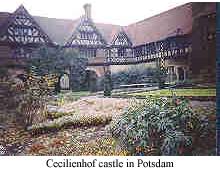 From July 17 until August 2, 1945, a conference
was held by the victorious powers who had defeated Germany. Truman,
Churchill and Stalin met at Cecilienhof castle in Potsdam near Berlin.
The Potsdam agreement, to a far greater extent than that of Yalta,
determined the shape of post war Europe. Among other important
decisions, they reached an agreement on how to divide the defeated
country between them: Not only was Germany parted in four zones (
French as well ), but the capital of the Third Reich was divided into
four sectors, with the Russians getting almost half of the city, which
became East Berlin, while the Western Allies shared the other half into
three sectors, which became West Berlin.
From July 17 until August 2, 1945, a conference
was held by the victorious powers who had defeated Germany. Truman,
Churchill and Stalin met at Cecilienhof castle in Potsdam near Berlin.
The Potsdam agreement, to a far greater extent than that of Yalta,
determined the shape of post war Europe. Among other important
decisions, they reached an agreement on how to divide the defeated
country between them: Not only was Germany parted in four zones (
French as well ), but the capital of the Third Reich was divided into
four sectors, with the Russians getting almost half of the city, which
became East Berlin, while the Western Allies shared the other half into
three sectors, which became West Berlin. 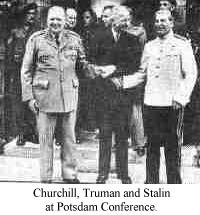 During the
following years Bonn became the capital of West Germany, and on Oct.6,
1949 the Russian occupied zone became the country of East Germany, a
country with a truly grand new name, calling themselves The German
Democratic Republic, with East Berlin its capital. We could travel
freely from West to East, which we often did, as almost everyone had
families in the Eastern part of Germany and East Berlin. Technically
West Berlin belonged to West Germany, although geographically it was
located in the center of East Germany. Anyone wanting to travel from
West Berlin to West Germany by road or rail, had to pass through East
German check points. In the early post war years these check points
were under the control of Russian military personnel.
During the
following years Bonn became the capital of West Germany, and on Oct.6,
1949 the Russian occupied zone became the country of East Germany, a
country with a truly grand new name, calling themselves The German
Democratic Republic, with East Berlin its capital. We could travel
freely from West to East, which we often did, as almost everyone had
families in the Eastern part of Germany and East Berlin. Technically
West Berlin belonged to West Germany, although geographically it was
located in the center of East Germany. Anyone wanting to travel from
West Berlin to West Germany by road or rail, had to pass through East
German check points. In the early post war years these check points
were under the control of Russian military personnel.
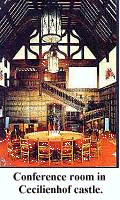
Over the years two, almost
predictable, things happened: West Berlin became a pulsating
metropolis, modeled after larger American cities, while East Berlin
with its strong ties to the Soviet Union became something of a
Mini-Moscow. The Soviet Union struggled against tremendous odds to get
back on its feet, after the terrible destruction of their country and
the unbelievable loss of millions of men in the war. Under the Soviet
system, the economic recovery was very slow and in some places hardly
at all. In most city stores the shelves remained half empty and the
goods available were of an inferior quality, unless one had enough
currency to buy goods in special stores near the western border, or in
the west period. For the most part, these goods remained unattainable
for the ordinary citizens. It was a similar situation in East Germany,
but it was most visible in East Berlin, where I had visited numerous
times.
On the morning of June 17, 1953, we awoke to radio
news that workers in East berlin were rioting in the streets. It soon
escalated and just before noon they were marching through the
Brandenburg Gate with the intension to consolidate with workers in West
Berlin. All came to a swift end, Russian tanks drew up and fired into
the unarmed crowd. They even fired through the Brandenburg Gate into
West Berlin, where a large group of people from East and West were
gathering to support the demonstrators. Ambulances from several
hospitals were rushed to the vicinity and I was in one of them. Eight
years after the last battle I again saw people lying in the streets,
shot to pieces. The Americans made a show of force with tanks and
troops, but did not intervene. British troops were there as well, I
could see them camped out in the wooded areas on both sides of the
street leading to the Brandenburg Gate, called the Tiergarten. I was
not only impressed, but also very grateful, with the restrain the
Americans showed on this day. It was the height of the Cold War, and it
would not have taken much to embroil all of us in Berlin and the rest
of the world into a terrible confrontation ( It was on this day that I
decided to leave my country, because I could see that relations between
the occupying nations would not improve in the near future. We were
caught directly between them. We were sitting on the proverbial powder
keg, and it was time to leave for somewhere, anywhere, as long as there
was peace ).
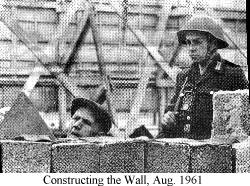 It is naturally human, wanting
to live like the relatives and friends in the west, and in the late
1950’s approx. 8000 to 10000 people left East Germany, East
Berlin in particular, each day for the west. East Germany could not
afford to lose so much man power. Many were specialized trades men as
well as members of the professions. The government of East Germany
found itself utterly helpless to stop their people from leaving in
droves.
It is naturally human, wanting
to live like the relatives and friends in the west, and in the late
1950’s approx. 8000 to 10000 people left East Germany, East
Berlin in particular, each day for the west. East Germany could not
afford to lose so much man power. Many were specialized trades men as
well as members of the professions. The government of East Germany
found itself utterly helpless to stop their people from leaving in
droves.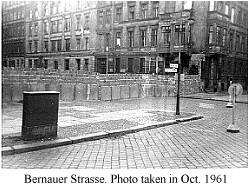 But
someone over there had an idea how to stop the people:
To build a wall, so high and booby trapped that no one would attempt to
climb over it and anyone who
dared to get through, would be shot. So, this infamous symbol of the
cold war was erected on August 13, 1961. It surprised Berliners on both
sides. Many East Berliners were working in the west and became
separated that night from their families for years.
But
someone over there had an idea how to stop the people:
To build a wall, so high and booby trapped that no one would attempt to
climb over it and anyone who
dared to get through, would be shot. So, this infamous symbol of the
cold war was erected on August 13, 1961. It surprised Berliners on both
sides. Many East Berliners were working in the west and became
separated that night from their families for years.
The Wall did not only divide Berlin right through
the center and all around the outer rim of the city, it also was built
on the border between West Germany and East Germany, reaching from the
Baltic Sea southward
through the center of Germany to the vicinity of Hildburghausen, where
it turned east towards the border of
Czechoslovakia.
People were numb at first, but when they saw whole blocks of houses
torn down and replaced with mined
death strips and guard towers, they knew that they were in for the long
haul.
It was not the first time that Germans came face to
face with hardship and adversity, so, they did the only thing they coud
do: They did their work and tried to go on with their lives. It became
easier with the passing of time. A new generation was growing up, who
had known nothing else, and soon a certain amount of pride in their
country was noticable. The government of East Germany poured millions
into sports, just like
big brother Russia. Training of the athletes began at an early age, was
strict and vigorous, and soon we could all see the results at the
Olympic Games, summer and winter: Russia and East Germany were the two
counties whose athletes took home the medals. But with all their show
of pride, and even their boasting to me about new stores at the
Alexander Platz, etc. on my visits to relatives through Checkpoint
Charlie with my Canadian passport, I could sense a certain pretense.
Something felt superficial.
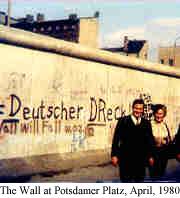 The years passed, but somehow
the undercurrent of discontent was never too far below the surface.
Once in a while some one tried to get through to the west. Only a few
made it, and in all 70 people lost their lives trying to get to the
other side, just to live in freedom. In all fairness it must be said
that the people of East Germany tried to make the best of it for over a
quarter of the century.
The years passed, but somehow
the undercurrent of discontent was never too far below the surface.
Once in a while some one tried to get through to the west. Only a few
made it, and in all 70 people lost their lives trying to get to the
other side, just to live in freedom. In all fairness it must be said
that the people of East Germany tried to make the best of it for over a
quarter of the century.
In the mid 1980’s we saw a change in
east-west relations. The freeze of the cold war started to thaw. A
change occured in the Soviet Union; Mikhail Gorbachev, an educated,
intelligent and seemingly caring man, appeared on the world stage,
voicing his concerns about the need of reconstruction of his own
country and the world in general. In 1987 he published a book called
"PERESTROIKA", which explains in detail his thinking. The new leader
addresses the world at large in his book: ”It is not easy to
change the approaches on which East-West relations have been built for
fifty years. But the new is knocking on every door and window.
It was indeed. In May 1989, West German Television
broadcasted the news that Hungary was opening its borders to Austria.
As airwaves know no boundaries, the people of East Germany saw it too.
By the hundreds they applied for travel visas, but the newly opened
border between Hungary and Austria remained off limits to them.
But by September 1989 so many people from East
Germany had arrived in Hungary, that something had to be done. For a
few hours, they allowed East Germans to cross into Austria, a total of
4,500, as a good-will gesture. The rest took refuge on the gounds of
the West German Embassy in Prague. Most slept in tents. Rain and mud
did not deter them; they were determined to leave all they had known
behind.
On October 6, 1989, East Germany celebrated their
40th anniversary of statehood. In the morning a military
parade marched through the city, with East German dignitaries looking
on. The guests of honour were there as well: Mikhail Gorbachev and his
wife Raisa. In the afternoon all was eerily quiet in the streets of
East Berlin. Not many ordinary citizens could be seen, but a lot of
agents of the Secret Service State Police (STASI) were milling around
with walkie-talkies and binoculars, making East Berlin looking like a
Hollywood spy thriller. That evening thousands of youg people were
called upon to take part in a grand torch-light parade.
Two days later, on October 8, a goup of pacifists
held a candle light vigil in a church in the city of Leipzig.
Thousands took to the streets, shouting "No more violence!" and "join
us, join us" echoed through every street. More and more people were
joining in and by October 16, the number of protesters had reached
literally millions. Loudspeakers could be heard throughout the city. I
would like to quote here their words of opposition:
"We have worked our fingers to the bone for this
country, and we are not standing by to see it all fall into ruins. The
truth has come to light. A nation that can not keep their young at
home, has no future."
"We, the people, demand:
1.) The right to free access of information.
2.) We demand the right to open political discussions.
3.) We demand the freedom of thoughts and creativity.
4.) We demand the right to maintain a plural ideology.
5.) We demand the right to dissent.
6.) We demand the right to travel freely.
7.) We demand the right to exert influence over
government authority.
8.) We demand the right to re-examine our beliefs.
9.) We, the people, demand the right to voice an opinion
in the affairs of state."
The government of East Germany felt compelled to give in. A
train left Prague for the west, filled with East Germans. On November
9, 1989, East German televison announced new travel regulations. East
German citizens could now travel without restriction to the west. It
took the world by surprise: THE WALL IS OPEN.
A tidal wave of thousands are making their way through the open
checkpoints. West Berliners were there in throngs to welcome them.
Disbelief turned into unequaled euphoria. West Germany announced that
every citizen from the East would receive welcome money in the amount
of DM 100.-( The East German mark had very little buying power. ) One
hundred west mark equaled about 55 Dollars. Not much, but for people,
for whom bananas and oranges were a luxury, it was a great deal. Long
lines of people could be seen at West Berlin banks.
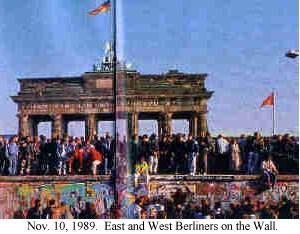 Elated beyond comprehension
nobody felt the cold during the night of Nov. 9/10. Around 4 AM they
were still celebrating in the streets of West Berlin. They were still
crowding into shops, mostly to look around or buy a few things to take
back home. No one who was there will ever forget it. On November 10 and
November 11 the flow from East to West was endless. The main artery of
West Berlin, the Kurfuerstendamm had to be closed to traffic. Tom
Brokaw was reporting for American television from the Brandenburg Gate,
the old symbol of the city. For 28 long years it has been part of the
wall. It was still closed, but dozens of people had climbed on the wall
in front of the Gate.
Elated beyond comprehension
nobody felt the cold during the night of Nov. 9/10. Around 4 AM they
were still celebrating in the streets of West Berlin. They were still
crowding into shops, mostly to look around or buy a few things to take
back home. No one who was there will ever forget it. On November 10 and
November 11 the flow from East to West was endless. The main artery of
West Berlin, the Kurfuerstendamm had to be closed to traffic. Tom
Brokaw was reporting for American television from the Brandenburg Gate,
the old symbol of the city. For 28 long years it has been part of the
wall. It was still closed, but dozens of people had climbed on the wall
in front of the Gate.
In the evening of November 11 the first concrete
slab was removed from the wall to the cheering of thousands. On
November 12 the Wall was opened at Potsdamer Platz, which once was one
of the busiest crossroads in Western Europe. Camera crews from around
the globe were waiting at the Brandenburg Gate. When will it be opened?
Finally, international journalists got the word: The Brandenburg Gate
will be open by Christmas!
The government in East Berlin took its time. On
December 22, the people of Berlin once again could claim the
Brandenburg Gate as their own! The happiest people were the ones
re-united with their families after
so many years. The people of Berlin knew who to thank. "Gorbi, Gorbi!"
they shouted. Gorbatschew was not only a name of a Russian vodka they
saw advertised on West Berlins busses!
On the occasion of the opening of Potsdamer Platz,
the Philharmonic orchestra in West Berlin held a benefit
concert for the poeple of the East. They played Beethoven’s
Seventh Symphony opus 92.
Leonard Bernstein, speaking in fluent German on the tape made for the
occasion of the fall of the Berlin wall, was overcome with emotion. No
one in our lifetime had expected this to happen. At a Christmas
concert, Berlin received a special gift: Leonard Bernstein conducted
the Philharmonic orchestra: They played Beethoven’s 9th
Symphony: Ode to Joy. To me it is the most moving of all the
symphonies, and it was most fitting for this occasion of unequaled joy.
Friedrich von Schiller write the words in 1785 and Beethoven put it to
music in 1799. In German it is ”Freude schoener
Goetterfunken.”. For anyone who wishes to obtain the lyrics,
click here.
This monstrous barrier, which had caused so much
grief and pain for so many, has become nothing but a sad memory. But
the most amazing wonder of it all: It happened without violence, it
happened because people wanted to live in peace and freedom.
Part 2 - My Homeland Reunited: The
Story of the Reunification of Germany
If you
enjoyed this story, visit  for more.
Click HERE
to send Ursula e-mail.
for more.
Click HERE
to send Ursula e-mail.
 From July 17 until August 2, 1945, a conference
was held by the victorious powers who had defeated Germany. Truman,
Churchill and Stalin met at Cecilienhof castle in Potsdam near Berlin.
The Potsdam agreement, to a far greater extent than that of Yalta,
determined the shape of post war Europe. Among other important
decisions, they reached an agreement on how to divide the defeated
country between them: Not only was Germany parted in four zones (
French as well ), but the capital of the Third Reich was divided into
four sectors, with the Russians getting almost half of the city, which
became East Berlin, while the Western Allies shared the other half into
three sectors, which became West Berlin.
From July 17 until August 2, 1945, a conference
was held by the victorious powers who had defeated Germany. Truman,
Churchill and Stalin met at Cecilienhof castle in Potsdam near Berlin.
The Potsdam agreement, to a far greater extent than that of Yalta,
determined the shape of post war Europe. Among other important
decisions, they reached an agreement on how to divide the defeated
country between them: Not only was Germany parted in four zones (
French as well ), but the capital of the Third Reich was divided into
four sectors, with the Russians getting almost half of the city, which
became East Berlin, while the Western Allies shared the other half into
three sectors, which became West Berlin.  During the
following years Bonn became the capital of West Germany, and on Oct.6,
1949 the Russian occupied zone became the country of East Germany, a
country with a truly grand new name, calling themselves The German
Democratic Republic, with East Berlin its capital. We could travel
freely from West to East, which we often did, as almost everyone had
families in the Eastern part of Germany and East Berlin. Technically
West Berlin belonged to West Germany, although geographically it was
located in the center of East Germany. Anyone wanting to travel from
West Berlin to West Germany by road or rail, had to pass through East
German check points. In the early post war years these check points
were under the control of Russian military personnel.
During the
following years Bonn became the capital of West Germany, and on Oct.6,
1949 the Russian occupied zone became the country of East Germany, a
country with a truly grand new name, calling themselves The German
Democratic Republic, with East Berlin its capital. We could travel
freely from West to East, which we often did, as almost everyone had
families in the Eastern part of Germany and East Berlin. Technically
West Berlin belonged to West Germany, although geographically it was
located in the center of East Germany. Anyone wanting to travel from
West Berlin to West Germany by road or rail, had to pass through East
German check points. In the early post war years these check points
were under the control of Russian military personnel.


 Ursula's History Web
Ursula's History Web It is naturally human, wanting
to live like the relatives and friends in the west, and in the late
1950’s approx. 8000 to 10000 people left East Germany, East
Berlin in particular, each day for the west. East Germany could not
afford to lose so much man power. Many were specialized trades men as
well as members of the professions. The government of East Germany
found itself utterly helpless to stop their people from leaving in
droves.
It is naturally human, wanting
to live like the relatives and friends in the west, and in the late
1950’s approx. 8000 to 10000 people left East Germany, East
Berlin in particular, each day for the west. East Germany could not
afford to lose so much man power. Many were specialized trades men as
well as members of the professions. The government of East Germany
found itself utterly helpless to stop their people from leaving in
droves. But
someone over there had an idea how to stop the people:
To build a wall, so high and booby trapped that no one would attempt to
climb over it and anyone who
dared to get through, would be shot. So, this infamous symbol of the
cold war was erected on August 13, 1961. It surprised Berliners on both
sides. Many East Berliners were working in the west and became
separated that night from their families for years.
But
someone over there had an idea how to stop the people:
To build a wall, so high and booby trapped that no one would attempt to
climb over it and anyone who
dared to get through, would be shot. So, this infamous symbol of the
cold war was erected on August 13, 1961. It surprised Berliners on both
sides. Many East Berliners were working in the west and became
separated that night from their families for years.
 The years passed, but somehow
the undercurrent of discontent was never too far below the surface.
Once in a while some one tried to get through to the west. Only a few
made it, and in all 70 people lost their lives trying to get to the
other side, just to live in freedom. In all fairness it must be said
that the people of East Germany tried to make the best of it for over a
quarter of the century.
The years passed, but somehow
the undercurrent of discontent was never too far below the surface.
Once in a while some one tried to get through to the west. Only a few
made it, and in all 70 people lost their lives trying to get to the
other side, just to live in freedom. In all fairness it must be said
that the people of East Germany tried to make the best of it for over a
quarter of the century.
 Elated beyond comprehension
nobody felt the cold during the night of Nov. 9/10. Around 4 AM they
were still celebrating in the streets of West Berlin. They were still
crowding into shops, mostly to look around or buy a few things to take
back home. No one who was there will ever forget it. On November 10 and
November 11 the flow from East to West was endless. The main artery of
West Berlin, the Kurfuerstendamm had to be closed to traffic. Tom
Brokaw was reporting for American television from the Brandenburg Gate,
the old symbol of the city. For 28 long years it has been part of the
wall. It was still closed, but dozens of people had climbed on the wall
in front of the Gate.
Elated beyond comprehension
nobody felt the cold during the night of Nov. 9/10. Around 4 AM they
were still celebrating in the streets of West Berlin. They were still
crowding into shops, mostly to look around or buy a few things to take
back home. No one who was there will ever forget it. On November 10 and
November 11 the flow from East to West was endless. The main artery of
West Berlin, the Kurfuerstendamm had to be closed to traffic. Tom
Brokaw was reporting for American television from the Brandenburg Gate,
the old symbol of the city. For 28 long years it has been part of the
wall. It was still closed, but dozens of people had climbed on the wall
in front of the Gate.
 for more.
Click HERE
to send Ursula e-mail.
for more.
Click HERE
to send Ursula e-mail.